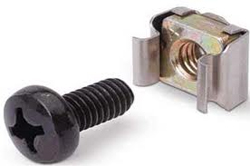Cage Nuts

A cage nut is a type of nut used in circumstances where there are chances of misalignment of components, and when the nut should be able to withstand stress and still keep at its place. These are square nuts that are held within a spring steel cage; the latter wraps around the nut. The cage is suitable for stressful jobs because the cage has two wings that are used to hold the steel cage in its position just as it holds the nut within it at its position. This allows the nut to be held at its place by the steel case. Here we talk about the advantages of cage nuts, how they are made, and uses they are put to.
Design and manufacture of Cage Nuts
The steel cage of the cage nuts is made out of either steel or stainless steel. Very often, it is also made out of spring steel. This is an important factor that helps keep the nut at its place – spring steel has very high yield strength that allows the cage to return to its original shape even after it has been deformed due to twisting or bending. Â
The nut itself is made out of steel or stainless steel. The combination of material used to make the nut and the cage is as follows: steel cage/steel nut, stainless cage/stainless nut and stainless cage, steel nut.
Many a times, the cage has two or more holes in it, which are used to hold the cage and nut onto the surface where they are installed. POP rivets are inserted into these holes to hold the cage there. The pop rivets are usually made out of nickel or copper.
Finally, the nut and cage assembly is given appropriate finish using Zinc or some other such substance. Â
Advantages and Uses of Cage Nuts
Cage nuts are a type of floating nuts – which allows them to be used in places where they can compensate for tolerances in build, process and design variances. They can be easily attached to any surface, either by pop rivets or just by compressing the cage together. With cage nuts, you do not need to do any welding or clinching with cage nuts you can affix them in their place using just pliers. This you do by closing the ears or the wings of the cage. The floating action of the nuts will mean that any misalignment will not mess up the installation completely, and the nut will keep at its place
Most commonly, cage nuts are used within the 19” rack mounting systems or computer cabinets s they are also known as. Other components where they are also used include shelves, UPSs, networking hardware and KVM switches. Â Â Â Â
The correct use of cage nuts will help you escape a lot of headache - because in stressful scenarios where you will see other nuts malfunction, cage nuts are just perfect for the jobs. We hope that this introduction will help you use them suitable n any project you may be involved in.
